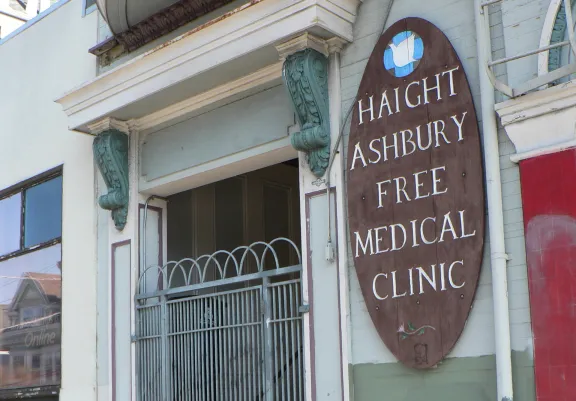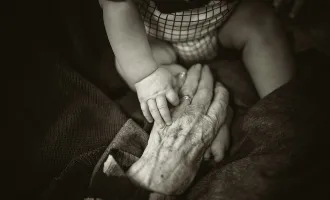
This Date in UCSF History: Haight-Ashbury: From ‘Free Love’ to ‘Speed Kills’
Originally published in Synapse on December 2, 1993. David E. Smith, MD, founder and director of the Haight-Ashbury Free Clinics, began treating young people using LSD in 1967 and has been on the front lines of drug treatment ever since. On Wednesday, Nov. 23, during a brown bag lecture entitled, “Current Drugs from the ‘60s to the ‘90s,” he provided a historical context for drug use “on the street” and made some predictions about the future. “Love needs care” was one of the slogans of the clinic when it opened during the Summer of Love in 1967.
The original goal was to treat the thousands of young people who had been drawn to San Francisco by the hippie lifestyle of “turn on, tune in, drop out.” In addition to treating infections, cold exposure and sexually transmitted diseases, Smith and his co-workers at the Free Clinic pioneered the talk-down technique for treating bad LSD trips, noting that a bad trip was often made much worse when treated in the hostile setting of a hospital emergency room.
The street scene changed rapidly after the clinic opened, reflecting a change in the prevalent drugs. The clientele went from being basically peace-loving, nomadic hippies having bad acid trips to violent, compulsive, addicted speed (amphetamine) abusers. Clinic workers saw clients experiencing meth-amphetamine-induced psychosis characterized by auditory and visual hallucinations and paranoia. During this time there was a pronounced increase in murders in the area, and by 1968 the Haight-Ashbury clinic was promoting the phrase, “Speed Kills.”
It was also during this period that Smith began to see the first spread of viral-borne infection through needle-sharing. Hepatitis was spread through group rituals involving intravenous amphetamine injection.
The rituals had strong sexual undertones, and although users began to be aware of the dangers of needle-sharing, they were unwilling to give it up. If a jaundiced, hepatitis-infected person was in the group, Smith said, the typical arrangement was to “put the yellow guy last.”
Smith began to advocate clean needle use at this time.
“What goes up, must come down,” he observed, and the drug to hit the scene after speed was heroin.
Before the advent of tranquilizers, some of the best psychiatric hospitals in Europe used intravenous morphine to treat acute psychoses. On the street, heroin, a morphine-like substance, served as an effective downer to the cocaine and speed that were in use.
With increased heroin use, the Haight-Ashbury drug culture became characterized by addiction and theft. A dramatic change in drug treatment occurred at the start of the ‘70s as a direct result of the Vietnam War. Tribesmen in Vietnam who had used opium for medicinal purposes began to refine it to heroin and to sell almost pure heroin to U.S. soldiers at very low prices.
Because the tribesmen fought the Viet Cong, the CIA supported their activities, including drug trafficking. Ultimately, large numbers of soldiers returned to the U.S. addicted on heroin. No longer was heroin addiction a problem of the disenfranchised, the runaways, the hippies, the criminals. The government had sent soldiers to Vietnam and brought back addicts.
This led to federally funded treatment programs and the Haight-Ashbury Free Clinic reaped the benefits.
As Smith put it, “I almost got arrested in 1967 for doing something I got federal funding for in 1971.” The 1970s were the heyday of drug treatment. It was also an era of rising cocaine use. The drug was primarily used by the white, upper-middle class, Smith said; it was a “stockbroker’s drug.”
Freebase cocaine was appealing because it created blood levels similar to those achieved with intravenous injection, but freebase was expensive, complicated to prepare and dangerous, as seen in the severe burning Richard Pryor suffered attempting to make it Cocaine was on the decline in the early 1980s until crack cocaine hit the market.
Here was a drug that was inexpensive, relatively easy to prepare and easy to administer. Because it was smoked, many people believe it was safer and less addicting than injected drugs. This was a dangerous misconception, Smith said, and crack fueled the next wave of the cocaine epidemic. Since it was less expensive and more accessible, the young and the poor were more likely to use it. The fact that the crack epidemic involved lower class, non-white people, Smith suggested, led to a change in public policy back toward criminalization and away from treatment.
Punitive and deterrent measures alone were not very effective, and Smith estimates that the drug problem in the United States was four times worse at the end of the 1980s than it was at the beginning of the decade. In the 19905, many of the old drugs are coming back, including LSD and much more potent marijuana. Smith said he sees a kind of generational forgetting wherein young people think they will be able to avoid the problems their elders faced in previous decades while still using the same drugs. The “new” drug since the late ‘80s is MDMA, commonly known as ecstasy, a designer drug related to methamphetamine.
This drug was actually first synthesized in 1914, and a 1968 Haight-Ashbury Clinic publication listed it as a rarely used psychedelic. The recent popularity of ecstasy is a tribute to clever marketing.
It is touted “to make sex better and give you insight while you’re doing it,” according to Smith.
It is popular at rave parties, and Smith is concerned about where its use will lead. MDMA is an expensive drug to produce, and he says that clinic workers are seeing an increase in methamphetamine-tainted ecstasy. Methamphetamine is relatively inexpensive and thus can drive down the cost of a dose of ecstasy.
Smith cited two MDMA-related deaths, one due to amphetamine-induced heart attack and one resulting from a seizure. Smith predicted that we are facing the beginning of another cycle in which the drug culture will become dominated by speed and its accompanying violence, and then will turn to heroin to come down again. He suggested that the death of actor River Phoenix from ingestion of a cocaine-heroin cocktail may foreshadow what is to come in the remainder of the 1995.



